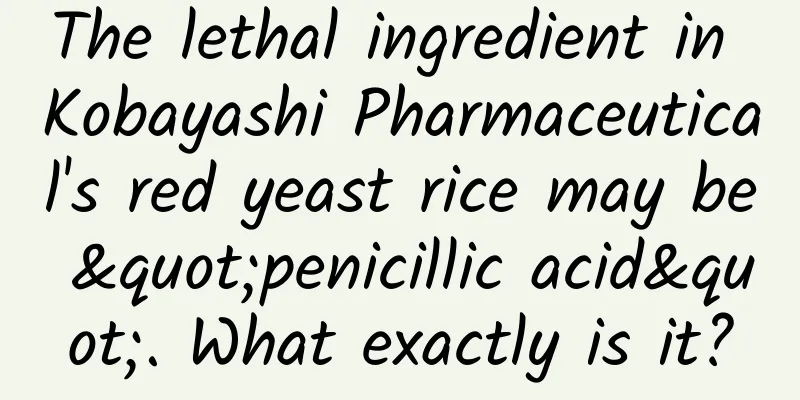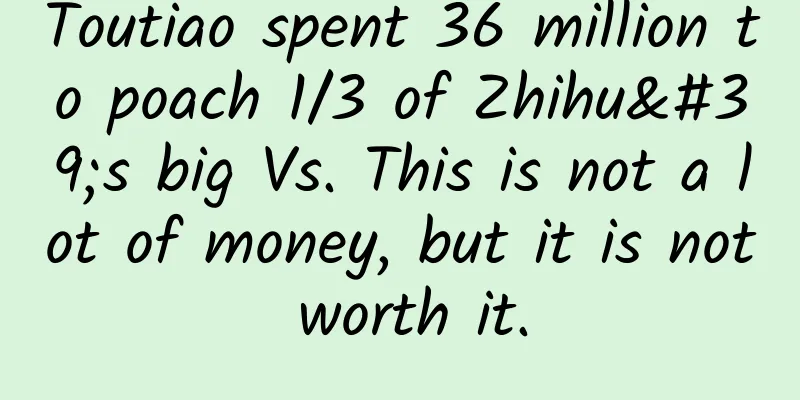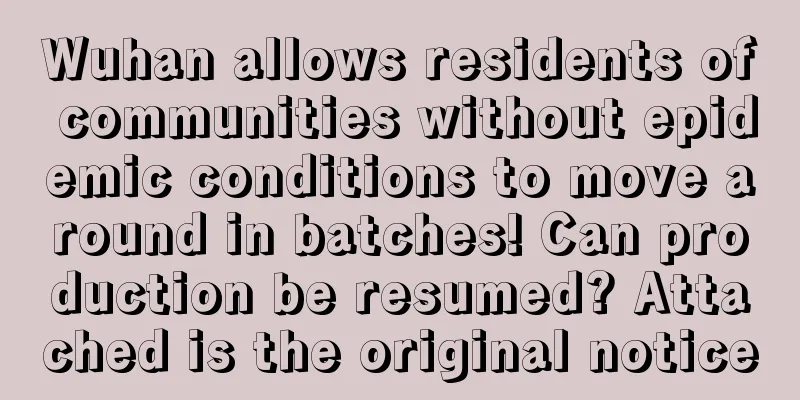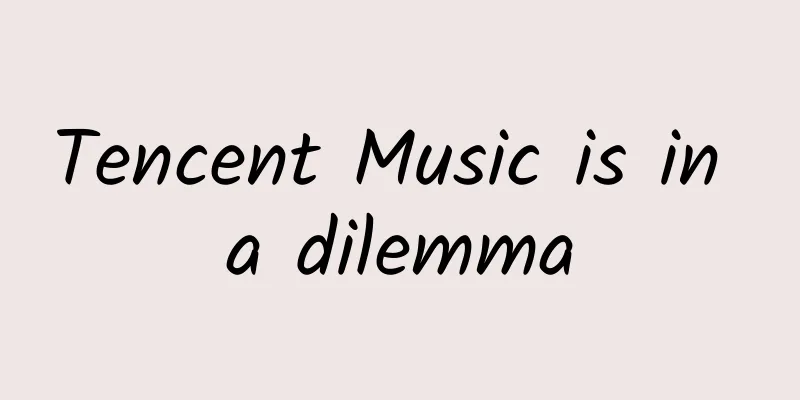The lethal ingredient in Kobayashi Pharmaceutical's red yeast rice may be "penicillic acid". What exactly is it?

|
Recently, Kobayashi Pharmaceutical, a well-known Japanese pharmaceutical company, has been pushed to the forefront and is experiencing the biggest crisis since its establishment in 1919. Some consumers developed kidney and other health problems after taking health products containing red yeast rice produced by the company. As of March 29, five consumers died suspected of taking the company's health products, and the number of hospitalized people has risen to 106. After the incident, Kobayashi Pharmaceutical urgently recalled three products containing the relevant ingredients, and the president of Kobayashi Pharmaceutical attended the press conference and bowed to apologize. For food and health products, such an accident is serious enough to be "recorded in history." On March 29, Kobayashi Pharmaceutical reported to the Ministry of Health, Labor and Welfare of Japan that the ingredient causing the problem in its red yeast rice products may be "penicillic acid". Kobayashi Pharmaceutical also stated that only specific batches of products contain this substance. So, what exactly is penicillic acid? Why does it appear in red yeast rice health supplements? Can we still safely consume health supplements and foods containing red yeast rice? This issue of "Health Focus" will answer your questions. 1. What exactly is “penicillic acid”? Why does it appear in red yeast rice health supplements? Speaking of Penicillium, I believe many people are familiar with it. The various antibiotics produced by Penicillium, such as penicillin, erythromycin, streptomycin, etc., have saved the lives of hundreds of millions of people. However, not all Penicillium can save lives. Some Penicillium can produce other toxins and even take people's lives. For example, the penicillic acid involved in this incident is a toxin produced by Penicillium. Penicillium toxins are usually resistant to high temperatures, and it is difficult to reduce their toxicity by heating or cooking. They mainly damage solid organs. Studies have found that long-term feeding of feed containing penicillic acid toxins can cause animal liver enlargement, liver cell degeneration, and inhibit animal cell DNA synthesis. In severe cases, it can cause animal cell DNA to break. At present, there are few reports on kidney toxicity caused by penicillic acid, and the correlation still needs to be confirmed. It is worth mentioning that penicillic acid can also work together with other mycotoxins to produce greater toxicity. So, why does penicillic acid appear in red yeast rice health products? The reason is that penicillic acid toxins are very easily produced in crops such as sorghum, barley, oats, wheat, corn and rice, and their yields are relatively high. They are the main mycotoxins in moldy feed. Red yeast rice is a red substance fermented by Monascus purpurogenous fungi, and rice is the main raw material for producing red yeast rice. Although the Ministry of Health, Labor and Welfare of Japan said that it is not clear how Penicillium was mixed in, it can be estimated that the red yeast rice incident was caused by the contamination of rice raw materials by Penicillium. 2. The red yeast rice fermentation process can produce other toxins Red yeast rice itself is harmless, and this has been proven for thousands of years. However, the fermentation process may make it toxic. In addition to penicillic acid, red yeast rice may produce aflatoxin and citrinin during the fermentation process. Excessive intake of aflatoxin can cause liver damage, poisoning, cancer, etc. Citrinin has strong nephrotoxicity and excessive intake can cause kidney damage. Experts once experimented with adding excessive amounts of citrinin to the food of small animals. The results showed that the animals developed kidney disease within 1 to 2 months, and that this toxin can cause malformations and cancer. At present, the academic community has made many efforts to control citrinin in red yeast rice, and various countries have also set limit standards. For example, Japan's limit standard is 200 micrograms/kg, the EU standard is 100 micrograms/kg, and China's limit standard for red yeast rice health products is 50 micrograms/kg, and the limit standard for red yeast rice in food additives is 50 micrograms/kg. Previously, Kobayashi Pharmaceutical tested the recalled products containing red yeast rice and ruled out the possibility of citrinin. Kobayashi said previously that "it may contain unexpected ingredients", which have now been confirmed to be penicillic acid. 3. Can I still eat health supplements and foods containing red yeast rice? After the Kobayashi Pharmaceutical incident, many people were worried, "Is there any problem with the red yeast rice health supplements I'm taking? Will it cause kidney toxicity?" Some people even dared not eat fermented bean curd and miso containing red yeast rice. According to Kobayashi Pharmaceutical, it produced a total of 18.5 tons of red yeast rice raw materials in 2023, 16 tons of which were sold to 52 companies for use in brewing and food manufacturing, including sake, biscuits, miso, bread, pickled squid, etc. That being said, a large number of "problematic red yeast rice" have indeed entered the market. Currently, Kobayashi Pharmaceutical has recalled all its products and issued recall requests to all companies that purchased red yeast rice raw materials. Some food, brewing and other companies that used the red yeast rice raw materials have also announced the recall of related products. According to a search conducted by Nandu.com's Wancai reporter on major e-commerce platforms, no products involved were found to be sold on mainland e-commerce platforms. In other words, it is highly unlikely that "toxic red yeast rice" products can be purchased on regular e-commerce platforms in my country. In addition, Kobayashi Pharmaceutical also stated that if Chinese consumers purchase related products through overseas cross-border platforms, overseas physical stores or other channels, Kobayashi Pharmaceutical will provide assistance in product recall. So can we still eat red yeast rice safely in the future? Since the "Red Yeast Incident" has not yet been completely concluded, we can only say that it is most likely caused by the contamination of the raw materials by Penicillium and the production of toxins during the fermentation process. In this regard, both manufacturers and regulatory agencies should pay more attention to the supervision and testing of raw materials, fermentation processes, and final products, and even formulate new testing standards, including adding tests for possible penicillin toxins. When consumers take red yeast rice as medicine or health care product, they need to pay attention to whether the active ingredients comply with national regulations and whether they are within the maximum edible dosage range. If the dosage exceeds the limit, it may cause damage to our body organs. China Food and Drug Administration has set standards for red yeast rice as a raw material for health products: the recommended daily intake of red yeast rice is tentatively set at no more than 2g. Lovastatin in the product should come from red yeast rice, and the total recommended daily intake of lovastatin is tentatively set at no more than 10mg. If the limit is exceeded, sufficient evidence of food safety should be provided. The product instructions add "children, pregnant women, and nursing mothers" to the list of unsuitable groups, and add "this product should not be used simultaneously with statins" to the precautions. (For lovastatin in red yeast rice, see the "Supplementary Reading" section.) As a food colorant, red yeast rice is allowed to be used in food categories such as milk, cakes, biscuits, and cooked meat products. According to the provisions of the "National Food Safety Standard for the Use of Food Additives" (GB2760-2014), the maximum amount of red yeast rice is 0.9g/kg. As long as the product is produced by a regular food factory, these doses are far from the level of harm to the body, and consumers do not need to worry too much about the red yeast rice problem. 【Supplementary reading】 Red yeast rice is a red substance fermented on rice by Monascus purpurogenum, which originated in the Han Dynasty. According to the Compendium of Materia Medica, red yeast rice is mainly used to promote digestion and blood circulation, strengthen the spleen and dry the stomach. In addition to being a traditional Chinese medicine, red yeast rice is also widely used in winemaking and food coloring. In 1979, Japanese scholars isolated an active substance that can inhibit cholesterol synthesis in the body from the fermentation broth of Monascus purpurogenous bacteria and named it Monacolin K (lovastatin). The physiologically active substances of Monascus purpurogenous bacteria began to attract people's attention. In 1985, two American scholars further discovered the mechanism of action of "Monacolin K" in inhibiting cholesterol synthesis, and were awarded the Nobel Prize in Physiology or Medicine in 1985. Since then, the active substance "Monacolin K" isolated from red yeast rice has a more well-known name - lovastatin, which is the active ingredient in the prescription cholesterol-lowering drug "statin". 【References】 [1] Li Xiaoxue, Dong Yanjie, Yuan Xuexia, et al. Contamination and prevention of penicillic acid in cereals and feed[J]. Journal of the Chinese Cereals and Oils Association, 2018, 33(11): 140-146. |
<<: Never put soda in the freezer, beware of explosion!
Recommend
February 2023 "Science" Rumor List: Is reconstituted milk "fake milk"? Does ovulation induction and egg retrieval lead to early menopause?
The list of "scientific" rumors for Feb...
If you want to supplement protein, you should eat more meat? You must eat enough of this kind of food
Mention protein supplementation Many people's...
Why did Apple's 3D Touch technology end in failure?
On September 21, why did Apple's 3D Touch fea...
The current situation of iOS buying volume market and advertising matters!
As we all know, Android has a large number of use...
Halfway through 2021, have internet celebrity brands collectively “collapsed”?
The excitement in the new consumer track reached ...
How much does it cost to develop a Changde home furnishing mini program?
How much does it cost to develop a Changde home f...
Little-known Lamborghini history records From the lowest Lamborghini to the world's first super SUV
[Sant'Agata Bolognese, September 7, 2021] Thr...
After experiencing the growth of Bilibili from 1 to 10, I have 5 profound insights
You will find that the larger the community, the ...
APP promotion: A brief discussion on the cold start of Internet products!
No matter how cool the concept of a product is or...
Are you ready for an in-depth look at Android 7.0?
On August 22, 2016, Google officially pushed the ...
Electric Technology Car News: Self-owned brands beat joint ventures? Which one should I buy between Borui and Mondeo for 200,000 yuan?
When talking about mid-size sedans, most people w...
APP wants to become popular overnight? 5 ways to become popular as long as you do it!
With the popularity of mobile Internet finance an...
How to write copy without any flaws? Here are 4 practical tips
How do top writers treat their writing? Hemingway...
The second half of search: Will WeChat do big search?
[[378650]] In the just-concluded WeChat 2021 Open...
AMD: By 2023, AMD CPU's share of the server market will exceed 25%
According to foreign media reports, chipmaker AMD...




![[Exclusive for lazy people] Universal RecylerAdapter, built-in XRecyclerView, compatible with pull-up and pull-down and animation, high reuse, universal for all pages, support empty pages](/upload/images/67ebdbabe7f3a.webp)




